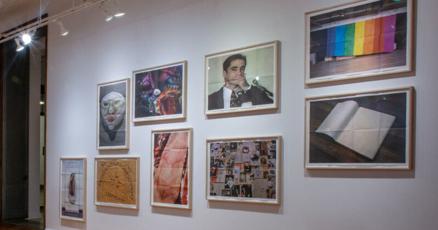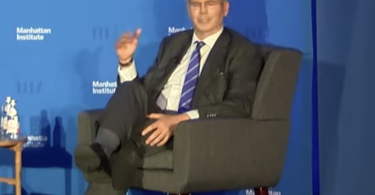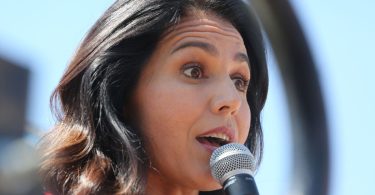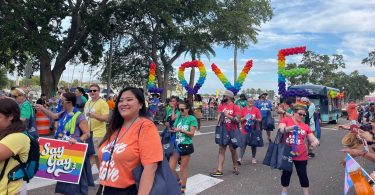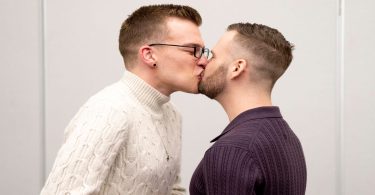A reverent, multifaceted exhibit at the Crowell and West Galleries at Union College delves into LGBTQ history through striking photography and a moving video installation.
Titled “Matthew Leifheit: Gay Archive,” the exhibit opened in September and will run through Nov. 12. It’s the first time the work has been shown.
Toward the start, a vibrant neon sign declaring “Foto Service” is featured above a photograph of an unlit, broken sign with the same phrase. The sign in the photograph is the original sign from Castro Camera shop, which was owned by Harvey Milk, the first openly gay man to be elected to public office in California.
Like many pieces in the exhibit, the sign brings new life to the original while paying homage to its history.
Leifheit, a Brooklyn-based photographer and professor, has been working on “Gay Archive” since 2021, when he began visiting and photographing queer archives around the country.
“During the 1970s and ’80s, independent archives were established by LGBTQ Americans to collect materials that major institutions would not,” Leifheit said in a statement. “These materials — pictures, letters, T-shirts, protest signs, ephemera, and the like — document queer culture and identity in the 20th century, in relation to the rise of the U.S. gay rights movement. More importantly, they contain the evidence of many peoples’ lives who would otherwise be lost to history, for reasons ranging from homophobia to racial prejudice, sexism and AIDS.”
Those materials are carefully laid out in Leifheit’s photographs. Polaroids are layered with letters, funeral home bills and even accessories. One photograph, printed on metal, highlights the archive of Lorraine Hurdle, a Black queer woman who served in the U.S. military during World War II. Photos of her during her time in the service are placed alongside a book and what might be Hurdle’s watch and glasses.
“Matt’s going into these archives, which so often it’s by volunteer that they’re being organized, so he’s often getting to the bottom of boxes and finding things that nobody’s looked at for decades or got lost in the archive,” said Rachel Stern, an assistant professor of photography at Union and curator of the exhibit. “He’s photographing them and bringing them out of the archive in the form of his photographs.”
“Gift Images” are on display at the center of the exhibit. One features an image of Pedro Zamora, an HIV/AIDS activist who was on season three of MTV’s “The Real World: San Francisco” and who became a beloved figure on the show. He was one of the first openly gay men with AIDS to be portrayed in a TV show and brought attention to the HIV/AIDs epidemic.
Another image highlights the archives of Judy Garland. Printed on newsprint, they play with the idea of longevity. While they’re framed and on view in the exhibit, copies are also stacked in a magazine rack and visitors are encouraged to take them.
“We love the idea of those becoming dorm-room posters,” Stern said.
It’s a way to bring LGBTQ history closer to students, and it seems to have struck a chord with some. When Stern was installing the exhibit a student, who was looking for a break from orientation, wandered into the gallery. The student told Stern they’re bisexual, something their family doesn’t know.
“They were in their first hours at college, away from their family, and had stumbled into a queer space and I really thought, ‘Wow, this is probably the first time this person has been in a queer space that is embracing them and giving them history and context,’ ” Stern said.
Other students have connected with the video projection featured in a curtained-off section of the exhibit. It loops 13 performances of gay men’s choruses, all from before effective treatment for HIV/AIDS became widely available in the U.S. The video and the audio are distorted in some places, reflecting the breakdown within the queer community.
“I’ve had a few students talk to me about weeping watching the gay chorus video,” Stern said.
“That’s been a very moving thing for me, is to think that one of the things that we’ve done is literally, physically create a space where people can come and feel the community that’s also recorded in the archives that Matt’s working with, and be part of it and add to it,” Stern said.
Stern hopes the exhibit is just the start for Leifheit’s “Gay Archives.”
“He was really generous to let us be the place to have it first. I hope this is one of many stops,” Stern said.
The Crowell and West Galleries are in the Feigenbaum Center for Visual Arts. For information or to take a virtual tour of the exhibit, visit union.edu.
More Life & Arts:
–

